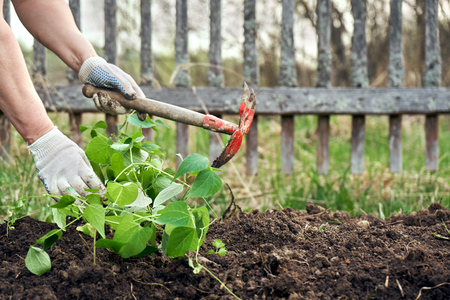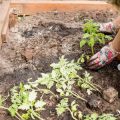1. Introduction to Organic Mulching
Organic mulching is a natural gardening practice that involves spreading biodegradable materials over the soil surface. These materials include things like shredded leaves, grass clippings, wood chips, bark, straw, and compost. Unlike synthetic mulches made from plastic or rubber, organic mulch breaks down over time and enriches the soil with nutrients.
What is Organic Mulch?
Organic mulch is derived from once-living materials. It serves multiple functions in a garden or landscape: it conserves moisture, regulates soil temperature, suppresses weeds, and improves soil structure as it decomposes. Since it naturally integrates into the environment, its an eco-friendly choice for both small gardens and large-scale landscapes.
Historical Use of Mulching in U.S. Agriculture
Mulching has deep roots in American agriculture and gardening traditions. Native American communities used natural ground covers like corn stalks and leaves to protect crops and improve yields. In colonial times, early settlers adopted similar practices using straw and manure to nourish their fields.
Common Traditional Mulching Materials in U.S. History
| Material | Region Used | Purpose |
|---|---|---|
| Corn husks & stalks | Midwest & Plains | Soil cover and nutrient recycling |
| Pine needles | Southeast | Weed control and soil acidification |
| Straw | Northeast & Midwest | Moisture retention for vegetable gardens |
| Seaweed | Coastal New England | Nutrient boost for sandy soils |
Why Its Popular Today Among American Gardeners
Organic mulching has seen a resurgence in popularity among home gardeners and landscapers across the U.S., thanks to growing interest in sustainable living and eco-friendly gardening techniques. Americans are becoming more aware of how gardening practices affect soil health, local ecosystems, and even climate resilience.
Main Reasons for Popularity of Organic Mulch:
- Sustainability: Made from natural waste products that decompose harmlessly.
- Soil Health: Adds organic matter to the soil, promoting beneficial microbial activity.
- Aesthetic Appeal: Enhances garden appearance with a natural look.
- Pest Control: Certain types like cedar chips can deter insects naturally.
- Cost-Effective: Many materials can be sourced locally or for free.
This blend of historical roots and modern ecological awareness makes organic mulching a smart choice for anyone looking to grow healthier plants while caring for the environment.
2. Types of Organic Mulch Materials
Organic mulch comes in many forms, each with its own benefits and best uses depending on your location, soil type, and gardening goals. In the U.S., some organic mulches are more popular in certain regions due to climate, availability, and local gardening practices. Below is a breakdown of common organic mulch materials used across the country.
Shredded Bark
Shredded bark is one of the most commonly used mulches in the U.S., especially in landscaped garden beds and around trees. Its usually made from pine, cedar, or hardwoods. Shredded bark breaks down slowly, offering long-lasting weed suppression and moisture retention. Its widely available at garden centers and home improvement stores.
Best for:
- Flower beds
- Around trees and shrubs
- Sloped areas (it stays in place better than lighter mulches)
Straw
Sourced from cereal crops like wheat or oats, straw is a popular choice for vegetable gardens. It’s lightweight, easy to spread, and helps prevent soil erosion while adding organic matter as it decomposes. Make sure to use clean straw that’s free of seeds to avoid introducing weeds.
Best for:
- Vegetable gardens
- Raised beds
- Temporary seasonal mulch
Grass Clippings
If you mow your lawn regularly, grass clippings can be a free and effective mulch option. They decompose quickly, adding nitrogen back into the soil. However, avoid using thick layers as they can mat down and block air circulation. Also, don’t use clippings from lawns treated with herbicides.
Best for:
- Vegetable gardens
- Flower beds (in thin layers)
Compost
Compost is a nutrient-rich mulch that also improves soil structure over time. It’s made from decomposed organic matter like kitchen scraps and yard waste. While it doesn’t suppress weeds as well as other mulches unless applied thickly, it’s ideal for gardeners looking to boost soil fertility naturally.
Best for:
- Perennial beds
- Vegetables and herbs
- Soil amendment before planting
Wood Chips
Wood chips are often available for free or at low cost from local tree services or municipal recycling centers. They’re chunkier than shredded bark and break down more slowly. While great for pathways and around trees, they’re not ideal for annual flower or vegetable beds because they can tie up nitrogen as they decompose.
Best for:
- Garden paths
- Around trees and shrubs
- Permanent landscaping areas
Comparison Table: Common Organic Mulch Materials in the U.S.
| Material | Main Benefit | Breakdown Speed | Common Uses | Regional Availability |
|---|---|---|---|---|
| Shredded Bark | Long-lasting coverage, weed control | Slow | Trees, shrubs, flower beds | Nationwide (especially Southeast & Pacific Northwest) |
| Straw | Erosion control, soil enrichment | Moderate to fast | Vegetable gardens | Midwest & rural farming areas |
| Grass Clippings | Nitrogen source, quick cover | Fast | Lawn edges, veggie beds (thin layers) | Nationwide (DIY source) |
| Compost | Nutrient boost & soil health | Moderate to fast | Beds needing fertility boost | Nationwide (home- or store-made) |
| Wood Chips | Aesthetics & weed suppression | Slow | Trees, paths, permanent areas | Nationwide (often free locally) |
Selecting the right type of organic mulch depends on your gardening needs and what materials are readily available in your region. By understanding how each material performs in different settings, you can make smarter choices that support healthy plant growth while minimizing maintenance.
![]()
3. How Organic Mulch Works: The Science Explained
Organic mulch does more than just make your garden look tidy—it plays a powerful role in improving soil health and supporting plant growth. Let’s break down the biological and chemical processes happening under that layer of mulch.
Soil Structure Improvement
As organic mulch breaks down, it adds organic matter to the soil. This helps create a crumbly texture that improves air and water flow. Better structure means roots can grow more easily, and beneficial organisms can move freely.
Benefits of Improved Soil Structure
| Benefit | How It Helps |
|---|---|
| Better Drainage | Prevents waterlogging and root rot |
| Improved Root Penetration | Encourages deeper root systems for stronger plants |
| Enhanced Aeration | Supports microbial activity and nutrient cycling |
Temperature Regulation
Mulch acts like a natural blanket for your soil. In the summer, it keeps the ground cooler by blocking direct sunlight. In colder months, it helps trap warmth, protecting plant roots from extreme temperature swings.
Seasonal Impact of Mulch on Soil Temperature
- Summer: Reduces heat stress on plants by keeping soil cooler.
- Winter: Minimizes freezing damage by insulating the soil.
Moisture Retention
A thick layer of organic mulch slows evaporation, helping the soil retain moisture longer. This means less frequent watering and healthier plants, especially during dry spells or drought conditions common in many U.S. regions.
Why Moisture Retention Matters:
- Saves water—great for eco-conscious gardeners and areas with water restrictions.
- Keeps plant roots consistently hydrated without overwatering.
Support for Microbial Life
Beneath the mulch, a bustling community of microbes works hard to break down organic materials into nutrients plants can absorb. These tiny organisms are essential for healthy soil biology and natural fertilization.
Main Soil Microorganisms Supported by Mulch
| Microbe Type | Role in Soil Health |
|---|---|
| Bacteria | Decompose organic matter and fix nitrogen |
| Fungi (like mycorrhizae) | Improve nutrient uptake and root health |
| Actinomycetes | Break down tough plant material like cellulose |
Together, these processes show how organic mulch is more than just ground cover—its a living, breathing part of your garden’s ecosystem that supports long-term plant health from the ground up.
4. Environmental and Ecological Benefits
Organic mulching isn’t just good for your garden—it’s also a win for the environment. By choosing organic materials like shredded leaves, bark, straw, or grass clippings, youre making a sustainable choice that supports healthier ecosystems and reduces your carbon footprint.
Reducing Landfill Waste
Every year, tons of yard waste—like leaves and grass clippings—end up in landfills. Instead of sending this valuable organic matter to the dump, you can use it as mulch in your garden. This helps cut down on landfill overflow and puts natural resources to good use right where they’re needed: in your soil.
Sequestering Carbon
Organic mulch plays a quiet but important role in fighting climate change. As it breaks down, it helps store—or sequester—carbon in the soil. This means less carbon dioxide is released into the atmosphere. Over time, this process improves soil health while reducing greenhouse gases.
Preventing Soil Erosion
Mulch acts like a protective blanket over your soil. It shields the ground from heavy rain and strong winds that can wash away topsoil. This is especially important on slopes or during stormy weather. Keeping your soil in place also means nutrients stay where plants can use them.
Promoting Biodiversity
A layer of organic mulch creates a habitat for earthworms, insects, fungi, and beneficial microbes—all essential players in a thriving garden ecosystem. These tiny organisms help break down mulch into nutrients that enrich the soil. Plus, diverse life below ground often supports more pollinators and birds above ground.
Quick Look: How Organic Mulch Helps the Environment
| Benefit | How It Helps |
|---|---|
| Reduces Landfill Waste | Keeps yard debris out of landfills by reusing it in gardens |
| Sequesters Carbon | Lowers greenhouse gas levels by storing carbon in soil |
| Prevents Erosion | Protects topsoil from being washed or blown away |
| Boosts Biodiversity | Supports healthy soil life and attracts helpful wildlife |
By incorporating organic mulch into your gardening routine, youre not only improving plant health but also contributing to a more sustainable environment. Its a small step with big ecological rewards.
5. Practical Tips for Applying Organic Mulch
Applying organic mulch the right way can make a big difference in your garden’s health and productivity. Whether youre growing vegetables, maintaining ornamental flower beds, or caring for trees, understanding when and how to apply mulch—especially tailored to your USDA hardiness zone—can enhance soil structure, retain moisture, and suppress weeds effectively.
When to Apply Mulch
Timing is key when it comes to mulching. Here’s a general guideline based on common USDA hardiness zones across the U.S.:
| USDA Zone | Best Time to Apply Mulch |
|---|---|
| Zones 3–5 (Northern U.S.) | Late spring after soil warms; late fall to protect perennials |
| Zones 6–7 (Midwest & Mid-Atlantic) | Spring after frost danger passes; fall for winter insulation |
| Zones 8–10 (Southern U.S.) | Early spring before peak heat; fall to preserve moisture |
| Zone 11+ (Tropical areas) | Year-round as needed to control evaporation and weeds |
How to Apply Mulch Based on Plant Type
Vegetable Gardens
- Depth: 1–2 inches for fine mulches like shredded leaves; up to 3 inches for coarse straw or bark.
- Avoid: Piling mulch directly against vegetable stems—it can cause rot.
- Tip: Use lighter-colored mulches during summer to reflect heat and keep roots cool.
Trees and Shrubs
- Depth: 2–4 inches of wood chips or bark nuggets works well.
- Avoid: Creating “mulch volcanoes” around trunks—leave a few inches of space.
- Tip: Extend mulch at least to the trees drip line for maximum root benefit.
Ornamental Flower Beds
- Depth: 2–3 inches using decorative bark, pine needles, or cocoa hulls.
- Avoid: Using fresh grass clippings unless composted first—they may mat and block water.
- Tip: Refresh mulch annually in spring to maintain appearance and effectiveness.
General Mulching Do’s and Don’ts
| Dos | Donts |
|---|---|
| Aerate soil lightly before applying mulch. | Pile mulch too high near plant stems or trunks. |
| Select mulch appropriate for your region and plant type. | Use synthetic materials in organic gardens. |
| Add compost beneath mulch for extra nutrients. | Apply thick layers that block air and water flow. |
| Replenish mulch as it breaks down over time. | Forget to check for pests hiding under dense mulch layers. |
The key is choosing the right organic material, applying it at the correct depth, and adjusting practices depending on your USDA zone. With these practical tips, you’ll help your garden thrive naturally while supporting long-term soil health.
6. Common Mistakes and How to Avoid Them
Organic mulching is a great way to improve soil health, retain moisture, and suppress weeds, but even well-meaning gardeners can make mistakes that reduce its effectiveness. Here are some of the most common mulching errors made by American gardeners and how you can avoid them.
Over-Mulching
One of the most frequent mistakes is piling mulch too high around plants, especially trees and shrubs. This practice, often called “mulch volcanoes,” can suffocate roots, trap moisture against stems, and invite pests or disease.
How to Avoid:
- Apply mulch in a layer thats 2–4 inches thick.
- Keep mulch at least a few inches away from the base of trunks and stems.
Using the Wrong Type of Mulch
Not all organic materials are suitable for every garden. For example, fresh grass clippings can mat down and create a slimy barrier, while certain wood chips may deplete nitrogen in the soil as they decompose.
How to Avoid:
| Mulch Material | Best Use | Avoid When |
|---|---|---|
| Bark or Wood Chips | Around trees & pathways | In vegetable beds (can tie up nitrogen) |
| Composted Leaves | Flower beds & veggie gardens | If not fully decomposed (may attract pests) |
| Grass Clippings | Thin layers in veggie gardens | If wet or applied thickly (can rot) |
Not Replenishing Mulch Regularly
Organic mulch breaks down over time, which is part of what makes it beneficial. But if you don’t top it off annually or as needed, it may stop providing the benefits youre after.
How to Avoid:
- Check your mulch levels each season.
- Add more as needed to maintain the ideal depth of 2–4 inches.
Poor Weed Control Before Mulching
Laying mulch directly over existing weeds wont always stop them from growing through. Weeds can push through thin mulch layers or regrow if not properly removed first.
How to Avoid:
- Remove existing weeds before applying mulch.
- Consider using a weed barrier like newspaper or cardboard under the mulch for added protection (but avoid plastic).
Ignoring Local Climate Conditions
Certain mulches perform better in specific climates. For example, straw works well in dry areas but may blow away in windy regions unless anchored properly.
How to Avoid:
- Select mulch types suited for your regions weather patterns.
- Secure lightweight mulches with netting or mix with heavier materials if wind is an issue.
Avoiding these common pitfalls will help you get the most out of your organic mulch and keep your garden thriving year-round.


